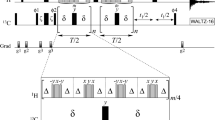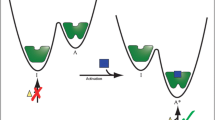Abstract
Carr–Purcell–Meiboom–Gill relaxation dispersion experiments are commonly used to probe biomolecular dynamics on the millisecond timescale. The simplest experiment involves using backbone 15N spins as probes of motion and pulse sequences are now available for providing accurate dispersion profiles in this case. In contrast, 1H-based experiments recorded on fully protonated samples are less common because of difficulties associated with homonuclear scalar couplings that can result in transfer of magnetization between coupled spins, leading to significant artifacts. Herein we examine a version of the 1HN CPMG experiment that has been used in our laboratory where a pair of CPMG pulse trains comprising non-selective, high power 1H refocusing pulses sandwich an amide selective pulse that serves to refocus scalar-coupled evolution by the end of the train. The origin of the artifacts in our original scheme is explained and a new, significantly improved sequence is presented. The utility of the new experiment is demonstrated by obtaining flat 1HN dispersion profiles in a protonated protein system that is not expected to undergo millisecond timescale dynamics, and subsequently by measuring profiles on a cavity mutant of T4 lysozyme that exchanges between a pair of distinct states, establishing that high quality data can be generated even for fully protonated samples.






Similar content being viewed by others
References
Boehr DD, McElheny D, Dyson HJ, Wright PE (2006) The dynamic energy landscape of dihydrofolate reductase catalysis. Science 313:1638–1642. https://doi.org/10.1126/science.1130258
Bouvignies G, Kay LE (2012) A 2D 13C-CEST experiment for studying slowly exchanging protein systems using methyl probes: an application to protein folding. J Biomol NMR 53:303–310. https://doi.org/10.1007/s10858-012-9640-7
Bouvignies G, Vallurupalli P, Hansen DF, Correia BE, Lange O, Bah A, Vernon RM, Dahlquist FW, Baker D, Kay LE (2011) Solution structure of a minor and transiently formed state of a T4 lysozyme mutant. Nature 477:111–114. https://doi.org/10.1038/nature10349
Bouvignies G, Vallurupalli P, Kay LE (2014) Visualizing side chains of invisible protein conformers by solution NMR. J Mol Biol 426:763–774. https://doi.org/10.1016/j.jmb.2013.10.041
Delaglio F, Grzesiek S, Vuister GW, Zhu G, Pfeifer J, Bax A (1995) NMRPipe: a multidimensional spectral processing system based on Unix pipes. J Biomol NMR 6:277–293. https://doi.org/10.1007/Bf00197809
Dill KA, Chan HS (1997) From Levinthal to pathways to funnels. Nat Struct Biol 4:10–19. https://doi.org/10.1038/nsb0197-10
Dittmer J, Bodenhausen G (2006) Quenching echo modulations in NMR spectroscopy. ChemPhysChem 7:831–836. https://doi.org/10.1002/cphc.200500403
Eriksson AE, Baase WA, Wozniak JA, Matthews BW (1992) A cavity-containing mutant of T4 lysozyme is stabilized by buried benzene. Nature 355:371–373. https://doi.org/10.1038/355371a0
Fawzi NL, Ying JF, Ghirlando R, Torchia DA, Clore GM (2011) Atomic-resolution dynamics on the surface of amyloid-β protofibrils probed by solution NMR. Nature 480:268–272. https://doi.org/10.1038/nature10577
Geen H, Freeman R (1991) Band-selective radiofrequency pulses. J Magn Reson 93:93–141. https://doi.org/10.1016/0022-2364(91)90034-q
Hansen DF, Vallurupalli P, Kay LE (2008a) An improved 15N relaxation dispersion experiment for the measurement of millisecond time-scale dynamics in proteins. J Phys Chem B 112:5898–5904. https://doi.org/10.1021/jp074793o
Hansen DF, Vallurupalli P, Lundström P, Neudecker P, Kay LE (2008b) Probing chemical shifts of invisible states of proteins with relaxation dispersion NMR spectroscopy: How well can we do? J Am Chem Soc 130:2667–2675. https://doi.org/10.1021/ja078337p
Hansen AL, Lundström P, Velyvis A, Kay LE (2012) Quantifying millisecond exchange dynamics in proteins by CPMG relaxation dispersion NMR using side-chain 1H probes. J Am Chem Soc 134:3178–3189. https://doi.org/10.1021/ja210711v
Henzler-Wildman K, Kern D (2007) Dynamic personalities of proteins. Nature 450:964–972. https://doi.org/10.1038/nature06522
Ishima R, Torchia DA (2000) Protein dynamics from NMR. Nat Struct Biol 7:740–743. https://doi.org/10.1038/78963
Ishima R, Torchia DA (2003) Extending the range of amide proton relaxation dispersion experiments in proteins using a constant-time relaxation-compensated CPMG approach. J Biomol NMR 25:243–248. https://doi.org/10.1023/A:1022851228405
Ishima R, Wingfield PT, Stahl SJ, Kaufman JD, Torchia DA (1998) Using amide 1H and 15N transverse relaxation to detect millisecond time-scale motions in perdeuterated proteins: Application to HIV-1 protease. J Am Chem Soc 120:10534–10542. https://doi.org/10.1021/ja981546c
Ishima R, Freedberg DI, Wang YX, Louis JM, Torchia DA (1999) Flap opening and dimer-interface flexibility in the free and inhibitor-bound HIV protease, and their implications for function. Structure 7:1047–1055. https://doi.org/10.1016/S0969-2126(99)80172-5
Ishima R, Baber J, Louis JM, Torchia DA (2004) Carbonyl carbon transverse relaxation dispersion measurements and ms–μs timescale motion in a protein hydrogen bond network. J Biomol NMR 29:187–198. https://doi.org/10.1023/B:JNMR.0000019249.50306.5d
Jiang B, Yu BH, Zhang X, Liu ML, Yang DW (2015) A 15N CPMG relaxation dispersion experiment more resistant to resonance offset and pulse imperfection. J Magn Reson 257:1–7. https://doi.org/10.1016/j.jmr.2015.05.003
Karplus M, Kuriyan J (2005) Molecular dynamics and protein function. Proc Natl Acad Sci USA 102:6679–6685. https://doi.org/10.1073/pnas.0408930102
Karplus M, McCammon JA (1983) Dynamics of proteins: elements and function. Annu Rev Biochem 52:263–300. https://doi.org/10.1146/annurev.bi.52.070183.001403
Korzhnev DM, Kloiber K, Kanelis V, Tugarinov V, Kay LE (2004a) Probing slow dynamics in high molecular weight proteins by methyl-TROSY NMR spectroscopy: application to a 723-residue enzyme. J Am Chem Soc 126:3964–3973. https://doi.org/10.1021/ja039587i
Korzhnev DM, Salvatella X, Vendruscolo M, Di Nardo AA, Davidson AR, Dobson CM, Kay LE (2004b) Low-populated folding intermediates of Fyn SH3 characterized by relaxation dispersion NMR. Nature 430:586–590. https://doi.org/10.1038/nature02655
Loria JP, Rance M, Palmer AG (1999) A relaxation-compensated Carr–Purcell–Meiboom–Gill sequence for characterizing chemical exchange by NMR spectroscopy. J Am Chem Soc 121:2331–2332. https://doi.org/10.1021/ja983961a
Lundström P, Hansen DF, Vallurupalli P, Kay LE (2009) Accurate measurement of alpha proton chemical shifts of excited protein states by relaxation dispersion NMR spectroscopy. J Am Chem Soc 131:1915–1926. https://doi.org/10.1021/ja807796a
Marion D, Ikura M, Tschudin R, Bax A (1989) Rapid recording of 2D NMR spectra without phase cycling. Application to the study of hydrogen exchange in proteins. J Magn Reson 85:393–399. https://doi.org/10.1016/0022-2364(89)90152-2
McConnell HM (1958) Reaction rates by nuclear magnetic resonance. J Chem Phys 28:430–431. https://doi.org/10.1063/1.1744152
Mittermaier A, Kay LE (2001) χ1 torsion angle dynamics in proteins from dipolar couplings. J Am Chem Soc 123:6892–6903. https://doi.org/10.1021/ja010595d
Mittermaier A, Kay LE (2006) New tools provide new insights in NMR studies of protein dynamics. Science 312:224–228. https://doi.org/10.1126/science.1124964
Mulder FAA, Skrynnikov NR, Hon B, Dahlquist FW, Kay LE (2001) Measurement of slow (μs–ms) time scale dynamics in protein side chains by 15N relaxation dispersion NMR spectroscopy: application to Asn and Gln residues in a cavity mutant of T4 lysozyme. J Am Chem Soc 123:967–975. https://doi.org/10.1021/ja003447g
Mulder FAA, Hon B, Mittermaier A, Dahlquist FW, Kay LE (2002) Slow internal dynamics in proteins: application of NMR relaxation dispersion spectroscopy to methyl groups in a cavity mutant of T4 lysozyme. J Am Chem Soc 124:1443–1451. https://doi.org/10.1021/jp0119806
Neudecker P, Robustelli P, Cavalli A, Walsh P, Lundström P, Zarrine-Afsar A, Sharpe S, Vendruscolo M, Kay LE (2012) Structure of an intermediate state in protein folding and aggregation. Science 336:362–366. https://doi.org/10.1126/science.1214203
Palmer AG, Massi F (2006) Characterization of the dynamics of biomacromolecules using rotating-frame spin relaxation NMR spectroscopy. Chem Rev 106:1700–1719. https://doi.org/10.1021/cr0404287
Palmer AG, Kroenke CD, Loria JP (2001) Nuclear magnetic resonance methods for quantifying microsecond-to-millisecond motions in biological macromolecules. Methods Enzymol 339:204–238. https://doi.org/10.1016/S0076-6879(01)39315-1
Sekhar A, Kay LE (2019) An NMR view of protein dynamics in health and disease. Annu Rev Biophys 48:297–319. https://doi.org/10.1146/annurev-biophys-052118-115647
Sekhar A, Rumfeldt JAO, Broom HR, Doyle CM, Bouvignies G, Meiering EM, Kay LE (2015) Thermal fluctuations of immature SOD1 lead to separate folding and misfolding pathways. eLife 4:e07296. https://doi.org/10.7554/elife.07296
Sekhar A, Velyvis A, Zoltsman G, Rosenzweig R, Bouvignies G, Kay LE (2018) Conserved conformational selection mechanism of Hsp70 chaperone-substrate interactions. eLife 7:e32764. https://doi.org/10.7554/elife.32764
Shaka AJ, Keeler J, Frenkiel T, Freeman R (1983) An improved sequence for broadband decoupling: WALTZ-16. J Magn Reson 52:335–338. https://doi.org/10.1016/0022-2364(83)90207-X
Sklenar V, Piotto M, Leppik R, Saudek V (1993) Gradient-tailored water suppression for 1H–15N HSQC experiments optimized to retain full sensitivity. J Magn Reson 102:241–245. https://doi.org/10.1006/jmra.1993.1098
Skrynnikov NR, Mulder FAA, Hon B, Dahlquist FW, Kay LE (2001) Probing slow time scale dynamics at methyl-containing side chains in proteins by relaxation dispersion NMR measurements: application to methionine residues in a cavity mutant of T4 lysozyme. J Am Chem Soc 123:4556–4566. https://doi.org/10.1021/ja004179p
Tollinger M, Skrynnikov NR, Mulder FAA, Forman-Kay JD, Kay LE (2001) Slow dynamics in folded and unfolded states of an SH3 domain. J Am Chem Soc 123:11341–11352. https://doi.org/10.1021/ja011300z
Vallurupalli P, Hansen DF, Stollar E, Meirovitch E, Kay LE (2007) Measurement of bond vector orientations in invisible excited states of proteins. Proc Natl Acad Sci USA 104:18473–18477. https://doi.org/10.1073/pnas.0708296104
Vallurupalli P, Sekhar A, Yuwen T, Kay LE (2017) Probing conformational dynamics in biomolecules via chemical exchange saturation transfer: a primer. J Biomol NMR 67:243–271. https://doi.org/10.1007/s10858-017-0099-4
Yip GNB, Zuiderweg ERP (2004) A phase cycle scheme that significantly suppresses offset-dependent artifacts in the R2-CPMG 15N relaxation experiment. J Magn Reson 171:25–36. https://doi.org/10.1016/j.jmr.2004.06.021
Yuwen T, Skrynnikov NR (2014) Proton-decoupled CPMG: a better experiment for measuring 15N R2 relaxation in disordered proteins. J Magn Reson 241:155–169. https://doi.org/10.1016/j.jmr.2013.08.008
Yuwen T, Vallurupalli P, Kay LE (2016) Enhancing the sensitivity of CPMG relaxation dispersion to conformational exchange processes by multiple-quantum spectroscopy. Angew Chem Int Ed 55:11490–11494. https://doi.org/10.1002/anie.201605843
Yuwen T, Huang R, Vallurupalli P, Kay LE (2019) A methyl-TROSY-based 1H relaxation dispersion experiment for studies of conformational exchange in high molecular weight proteins. Angew Chem Int Ed 58:6250–6254. https://doi.org/10.1002/anie.201900241
Acknowledgements
This work was supported by grants from the Canadian Institutes of Health Research (CIHR) and the Natural Sciences and Engineering Research Council of Canada (NSERC) to L.E.K. T.Y. acknowledges post-doctoral support from the CIHR. We thank Pramodh Vallurupalli for useful discussions about exchange dynamics in L99A T4L. L.E.K. holds a Canada Research Chair in Biochemistry.
Author information
Authors and Affiliations
Corresponding author
Additional information
Publisher's Note
Springer Nature remains neutral with regard to jurisdictional claims in published maps and institutional affiliations.
Electronic supplementary material
Below is the link to the electronic supplementary material.
Rights and permissions
About this article
Cite this article
Yuwen, T., Kay, L.E. Revisiting 1HN CPMG relaxation dispersion experiments: a simple modification can eliminate large artifacts. J Biomol NMR 73, 641–650 (2019). https://doi.org/10.1007/s10858-019-00276-y
Received:
Accepted:
Published:
Issue Date:
DOI: https://doi.org/10.1007/s10858-019-00276-y




